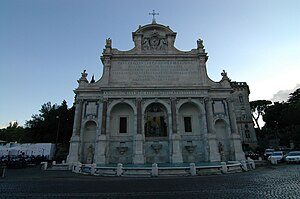
The Aqua Traiana (later rebuilt and named the Acqua Paola) was a 1st-century Roman acqueduct built by Emperor Trajan and inaugurated on 24 June 109 AD.[1] It channelled water from sources around Lake Bracciano, 40 kilometers (25 mi) north-west of Rome, to Rome in ancient Roman times but had fallen into disuse by the 17th century. It fed water mills arranged in a parallel sequence at theJaniculum, under the present American Academy in Rome. The milling complex had a long history, and were famously put out of action by the Ostrogoths when they cut the aqueduct in 537 during the first siege of Rome. Belisarius restored the supply of grain by using mills floating in the Tiber. The complex of mills bears parallels with a similar complex at Barbegal in southern Gaul.
Original Sources of the Aqueduct
Both the ancient Aqua Traiana and the modern Acqua Paola were fed by a collection of aquifer sources in the hills around the volcanic basin of Lake Bracciano. The Italian archaeologist Alberto Cassio in his Route of the Ancient Waters, and his successor Rodolfo Lanciani in 1881 in his Commentary on Frontinus list the sources in the following groups, running clockwise around the lake from Bracciano:

- The seven sources in the Villa Flavia / Fosso di Grotta Renara area. These were gathered together into three tanks named by Cassio and Lanciani as Greca, Spineta and Pisciarello. The seventeenth Century architect Carlo Fontana names three tanks as: Botte Greca, Botte Ornava, and Botte Arciprete (Arch-Priest) then places one additional tank further down the Fosso di Grotta Renara as the Botte di Pisciarelli. One tank is currenly called 'Fonte Micciaro'.
- The sources in the Fosso di Fiora area: These include the source at the monumental Fiora Nymphaeum, another source at the 'Carestia' Nymphaeum approx 1km from the Fiora, which now lies in ruin, but is documented by various maps in the Orsini collection.
- A collection of sources at the Vicarello Baths
- One source close to the contemporary Acqua delle Donne Restaurant.
- The Sette Botti (seven tanks) immediately to the East of the Acqua delle Donna.
- Various sources to the north of Monte Rocca Romana in the territory of Bassano Romano and along the Fosso della Calandrina including the notable Fonte Ceraso.
- The Aquarelli sources to the North East of the Lake.
- The Acqua D'Impolline due East of the Lake
Source
Creative Commons Attribution-ShareAlike License

No comments:
Post a Comment